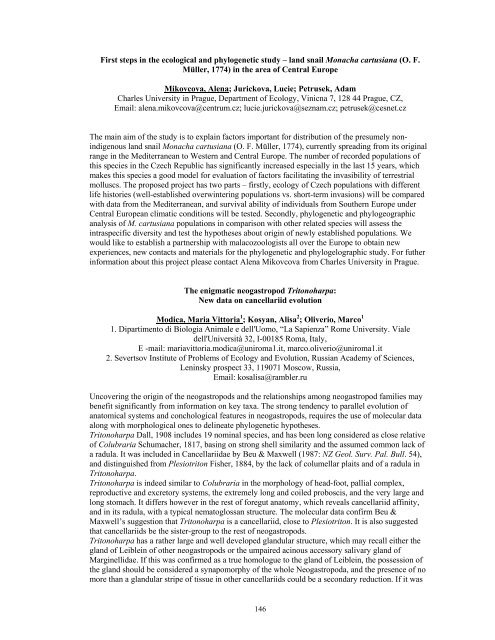World Congress of Malacology Antwerp ... - Unitas Malacologica
World Congress of Malacology Antwerp ... - Unitas Malacologica
World Congress of Malacology Antwerp ... - Unitas Malacologica
Create successful ePaper yourself
Turn your PDF publications into a flip-book with our unique Google optimized e-Paper software.
First steps in the ecological and phylogenetic study – land snail Monacha cartusiana (O. F.<br />
Müller, 1774) in the area <strong>of</strong> Central Europe<br />
Mikovcova, Alena; Jurickova, Lucie; Petrusek, Adam<br />
Charles University in Prague, Department <strong>of</strong> Ecology, Vinicna 7, 128 44 Prague, CZ,<br />
Email: alena.mikovcova@centrum.cz; lucie.jurickova@seznam.cz; petrusek@cesnet.cz<br />
The main aim <strong>of</strong> the study is to explain factors important for distribution <strong>of</strong> the presumely nonindigenous<br />
land snail Monacha cartusiana (O. F. Müller, 1774), currently spreading from its original<br />
range in the Mediterranean to Western and Central Europe. The number <strong>of</strong> recorded populations <strong>of</strong><br />
this species in the Czech Republic has significantly increased especially in the last 15 years, which<br />
makes this species a good model for evaluation <strong>of</strong> factors facilitating the invasibility <strong>of</strong> terrestrial<br />
molluscs. The proposed project has two parts – firstly, ecology <strong>of</strong> Czech populations with different<br />
life histories (well-established overwintering populations vs. short-term invasions) will be compared<br />
with data from the Mediterranean, and survival ability <strong>of</strong> individuals from Southern Europe under<br />
Central European climatic conditions will be tested. Secondly, phylogenetic and phylogeographic<br />
analysis <strong>of</strong> M. cartusiana populations in comparison with other related species will assess the<br />
intraspecific diversity and test the hypotheses about origin <strong>of</strong> newly established populations. We<br />
would like to establish a partnership with malacozoologists all over the Europe to obtain new<br />
experiences, new contacts and materials for the phylogenetic and phylogelographic study. For futher<br />
information about this project please contact Alena Mikovcova from Charles University in Prague.<br />
The enigmatic neogastropod Tritonoharpa:<br />
New data on cancellariid evolution<br />
Modica, Maria Vittoria 1 ; Kosyan, Alisa 2 ; Oliverio, Marco 1<br />
1. Dipartimento di Biologia Animale e dell'Uomo, “La Sapienza” Rome University. Viale<br />
dell'Università 32, I-00185 Roma, Italy,<br />
E -mail: mariavittoria.modica@uniroma1.it, marco.oliverio@uniroma1.it<br />
2. Severtsov Institute <strong>of</strong> Problems <strong>of</strong> Ecology and Evolution, Russian Academy <strong>of</strong> Sciences,<br />
Leninsky prospect 33, 119071 Moscow, Russia,<br />
Email: kosalisa@rambler.ru<br />
Uncovering the origin <strong>of</strong> the neogastropods and the relationships among neogastropod families may<br />
benefit significantly from information on key taxa. The strong tendency to parallel evolution <strong>of</strong><br />
anatomical systems and conchological features in neogastropods, requires the use <strong>of</strong> molecular data<br />
along with morphological ones to delineate phylogenetic hypotheses.<br />
Tritonoharpa Dall, 1908 includes 19 nominal species, and has been long considered as close relative<br />
<strong>of</strong> Colubraria Schumacher, 1817, basing on strong shell similarity and the assumed common lack <strong>of</strong><br />
a radula. It was included in Cancellariidae by Beu & Maxwell (1987: NZ Geol. Surv. Pal. Bull. 54),<br />
and distinguished from Plesiotriton Fisher, 1884, by the lack <strong>of</strong> columellar plaits and <strong>of</strong> a radula in<br />
Tritonoharpa.<br />
Tritonoharpa is indeed similar to Colubraria in the morphology <strong>of</strong> head-foot, pallial complex,<br />
reproductive and excretory systems, the extremely long and coiled proboscis, and the very large and<br />
long stomach. It differs however in the rest <strong>of</strong> foregut anatomy, which reveals cancellariid affinity,<br />
and in its radula, with a typical nematoglossan structure. The molecular data confirm Beu &<br />
Maxwell’s suggestion that Tritonoharpa is a cancellariid, close to Plesiotriton. It is also suggested<br />
that cancellariids be the sister-group to the rest <strong>of</strong> neogastropods.<br />
Tritonoharpa has a rather large and well developed glandular structure, which may recall either the<br />
gland <strong>of</strong> Leiblein <strong>of</strong> other neogastropods or the umpaired acinous accessory salivary gland <strong>of</strong><br />
Marginellidae. If this was confirmed as a true homologue to the gland <strong>of</strong> Leiblein, the possession <strong>of</strong><br />
the gland should be considered a synapomorphy <strong>of</strong> the whole Neogastropoda, and the presence <strong>of</strong> no<br />
more than a glandular stripe <strong>of</strong> tissue in other cancellariids could be a secondary reduction. If it was<br />
146



